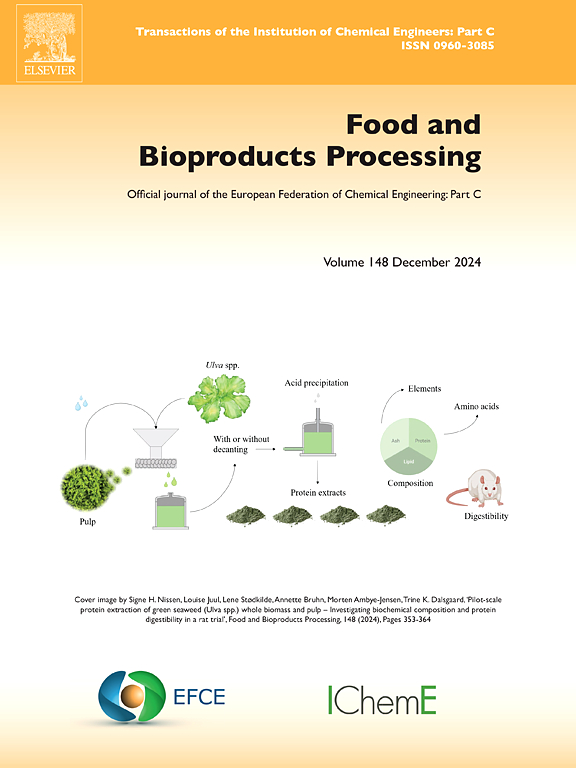Recovery of health-promoting phenolic compounds from clove basil (Ocimum gratissimum L.) by aqueous extraction and ultrafiltration
IF 3.5
2区 农林科学
Q2 BIOTECHNOLOGY & APPLIED MICROBIOLOGY
引用次数: 0
Abstract
Clove basil, a medicinal plant found in tropical areas, presents significant phytochemicals with high antioxidant capacity. In this study, we investigated the extraction kinetics of phenolic compounds from clove basil leaves, followed by the concentration and purification of the extract by ultrafiltration. The extraction profile followed the pseudo-second-order kinetic model and the maximum total phenolic content (TPC) of 320.29 ± 1.82 mg of gallic acid equivalents (GAE) per g of dried extract (mgGAE g−1) was achieved after 120 min of aqueous extraction at 75 °C and solid: liquid ratio of 1:100. The DPPH assay revealed an antioxidant capacity of 2493.54 ± 77.61 µmol of Trolox equivalent (TE) per g of dried extract (µmol TE g−1) for the clove basil extract. The aqueous extract presented concentrations of 22.18 ± 0.16 and 5.96 ± 0.34 mg g−1 for rosmarinic and chlorogenic acids, respectively, and significant quantities of other phenolic acids. Ultrafiltration through a 10 kDa polymeric membrane was efficient in producing a clear permeate stream by reducing 64.82 ± 7.77 % of total solids and 84.01 ± 1.13 % of turbidity. The membrane filtration retained 76.80 ± 0.59 % of polyphenol compounds and 52.52 ± 0.04 % of rosmarinic acid. Thus, the ultrafiltration process is an appropriate alternative for recovering and concentrating bioactive molecules from clove basil leaf extract.
用水萃取和超滤法从罗勒中回收有益健康的酚类化合物
罗勒是热带地区的一种药用植物,具有很高的抗氧化能力。本研究研究了罗勒叶中酚类化合物的提取动力学,并对提取液进行了超滤浓缩和纯化。在75 °C、料液比为1:100的条件下,水浸120 min,得到的最大总酚含量(TPC)为320.29 ± 1.82 mg / g没食子酸当量(mgGAE g−1)。DPPH实验显示丁香罗勒提取物的抗氧化能力为2493.54 ± 77.61µmol Trolox当量(TE) / g(µmol TE g−1)。水提物中迷迭香和绿原酸的浓度分别为22.18 ± 0.16和5.96 ± 0.34 mg g−1,其他酚酸含量也相当可观。通过10 kDa聚合物膜进行超滤,总固形物减少64.82 ± 7.77 %,浊度减少84.01 ± 1.13 %,可产生清晰的渗透流。膜过滤后多酚类化合物的保留率为76.80 ± 0.59 %,迷迭香酸的保留率为52.52 ± 0.04 %。因此,超滤工艺是从罗勒叶提取物中提取和浓缩生物活性分子是一种合适的替代方法。
本文章由计算机程序翻译,如有差异,请以英文原文为准。
求助全文
约1分钟内获得全文
求助全文
来源期刊

Food and Bioproducts Processing
工程技术-工程:化工
CiteScore
9.70
自引率
4.30%
发文量
115
审稿时长
24 days
期刊介绍:
Official Journal of the European Federation of Chemical Engineering:
Part C
FBP aims to be the principal international journal for publication of high quality, original papers in the branches of engineering and science dedicated to the safe processing of biological products. It is the only journal to exploit the synergy between biotechnology, bioprocessing and food engineering.
Papers showing how research results can be used in engineering design, and accounts of experimental or theoretical research work bringing new perspectives to established principles, highlighting unsolved problems or indicating directions for future research, are particularly welcome. Contributions that deal with new developments in equipment or processes and that can be given quantitative expression are encouraged. The journal is especially interested in papers that extend the boundaries of food and bioproducts processing.
The journal has a strong emphasis on the interface between engineering and food or bioproducts. Papers that are not likely to be published are those:
• Primarily concerned with food formulation
• That use experimental design techniques to obtain response surfaces but gain little insight from them
• That are empirical and ignore established mechanistic models, e.g., empirical drying curves
• That are primarily concerned about sensory evaluation and colour
• Concern the extraction, encapsulation and/or antioxidant activity of a specific biological material without providing insight that could be applied to a similar but different material,
• Containing only chemical analyses of biological materials.
 求助内容:
求助内容: 应助结果提醒方式:
应助结果提醒方式:


